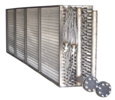Water Coil Piping

Chilled water coils and hot water coils typically have identical connection layouts. I'll leave this post generic so the following should apply to either a chilled water coil or hot water coil.
There are two main factors to consider when piping up a water coil.
If any fluid is left in an inactive coil while exposed to low ambient temperatures, the fluid in the tubes can freeze. This can cause swelling, bursts, and rupture in the coil tubes. Fluid coils are typically piped internally so that water can be purged by gravity when the coil is disconnected or the vent and drain plugs are removed.
You can see the blue areas where water is likely to get trapped, even if drains are pulled.
In this one, you can see that if the connections or plugs are removed, gravity will escort the fluid out of the coil properly.
In any heat exchanger, counterflow (or countercurrent flow) must achieved to obtain optimum performance. It has a significant performance advantage over parallel flow (or concurrent flow). Counterflow means that the direction of each medium must be opposite one another.
In our water coil case, the water must move in the opposite direction as the air. Here is a right hand coil example:
It's almost impossible to remove all the air from a water system. Air pockets and bubbles will have a hard time escaping if the water is flowing downward, while the bubbles tend to flow upward. That is why we typically build fluid coils with a low supply connection and a high return. The water flows up, so it's not fighting against the natural path of air pockets.
Air entrapment isn't a primary concern, and the phenomenon is somewhat debatable. If there is a reason to choose downward fluid flow, it shouldn't be a problem.
To make it easy, here are some more general tips (or the TL;DR version).
